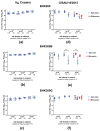Cell Density Effects in Different Cell Culture Media and Their Impact on the Propagation of Foot-And-Mouth Disease Virus
- PMID: 31167384
- PMCID: PMC6631978
- DOI: 10.3390/v11060511
Cell Density Effects in Different Cell Culture Media and Their Impact on the Propagation of Foot-And-Mouth Disease Virus
Abstract
Foot-and-mouth disease virus (FMDV) is endemic in many parts of the world. Vaccination is an important control measure, limits viral spread, and can help to eradicate the disease. However, vaccination programs are cost-intensive because of the short shelf life of vaccines and the need for frequent re-vaccination. Animal-component-free (ACF) or chemically defined media (CDM) at high cell densities are a promising approach for the production of inexpensive high-quality vaccines, but the occurrence of cell density effects has been reported for various virus-cell systems in vaccine production. For FMDV, the use of CDM or ACF media for vaccine production has not been studied and no information about cell density effects is available. This work describes the propagation of FMDV in ACF or in CDM. Cells were grown at increasing cell densities and either 100% media exchange or addition of 30% fresh media was performed before infection with FMDV. Increasing cell densities reduced the viral titer and increased yield variability in all media except BHK300G. This effect can be mitigated by performing a 100% media exchange before infection or when using the controlled environment of a bioreactor. The media composition and also a fragile relationship between virus and cell metabolism seem to be causal for that phenomenon.
Keywords: animal-component-free media; antifoam; cell density; chemically defined media; foot-and-mouth disease virus; suspension cells.
Conflict of interest statement
M.B. and M.E. declare that they have no competing interests. The project, including V.D.’s salary, was funded by Merck Life Sciences. A.Z. and J.E. are employees of Merck Life Sciences. Merck Life Sciences participated in the design of the study, as well as in the collection and analysis of the data and the final review of the manuscript. The funders had no role in the interpretation of data, the writing of the manuscript or in the decision to publish the results.
Figures






Similar articles
-
Investigation of cell culture conditions for optimal foot-and-mouth disease virus production.BMC Biotechnol. 2019 Jun 7;19(1):33. doi: 10.1186/s12896-019-0527-5. BMC Biotechnol. 2019. PMID: 31174517 Free PMC article.
-
Influence of cell type and cell culture media on the propagation of foot-and-mouth disease virus with regard to vaccine quality.Virol J. 2018 Mar 16;15(1):46. doi: 10.1186/s12985-018-0956-0. Virol J. 2018. PMID: 29548334 Free PMC article.
-
Cell culture propagation of foot-and-mouth disease virus: adaptive amino acid substitutions in structural proteins and their functional implications.Virus Genes. 2020 Feb;56(1):1-15. doi: 10.1007/s11262-019-01714-7. Epub 2019 Nov 27. Virus Genes. 2020. PMID: 31776851 Free PMC article. Review.
-
Cell density-dependent expression of viral antigens during persistence of foot-and-mouth disease virus in cell culture.Virology. 2010 Jul 20;403(1):47-55. doi: 10.1016/j.virol.2010.04.005. Epub 2010 May 4. Virology. 2010. PMID: 20444479
-
Development of vaccines toward the global control and eradication of foot-and-mouth disease.Expert Rev Vaccines. 2011 Mar;10(3):377-87. doi: 10.1586/erv.11.4. Expert Rev Vaccines. 2011. PMID: 21434805 Review.
Cited by
-
SARS-CoV-2 Production in a Scalable High Cell Density Bioreactor.Vaccines (Basel). 2021 Jun 29;9(7):706. doi: 10.3390/vaccines9070706. Vaccines (Basel). 2021. PMID: 34209694 Free PMC article.
-
Extracellular vesicle depletion and UGCG overexpression mitigate the cell density effect in HEK293 cell culture transfection.Mol Ther Methods Clin Dev. 2024 Jan 17;32(1):101190. doi: 10.1016/j.omtm.2024.101190. eCollection 2024 Mar 14. Mol Ther Methods Clin Dev. 2024. PMID: 38327808 Free PMC article.
-
High-Titer Hepatitis C Virus Production in a Scalable Single-Use High Cell Density Bioreactor.Vaccines (Basel). 2022 Feb 7;10(2):249. doi: 10.3390/vaccines10020249. Vaccines (Basel). 2022. PMID: 35214707 Free PMC article.
-
High-Titer Recombinant Adenovirus 26 Vector GMP Manufacturing in HEK 293 Cells with a Stirred Single-Use Bioreactor for COVID-19 Vaccination Purposes.ACS Omega. 2023 Oct 2;8(40):36720-36728. doi: 10.1021/acsomega.3c03007. eCollection 2023 Oct 10. ACS Omega. 2023. PMID: 37841195 Free PMC article.
-
Establishment of a Suspension MDBK Cell Line in Serum-Free Medium for Production of Bovine Alphaherpesvirus-1.Vaccines (Basel). 2021 Sep 9;9(9):1006. doi: 10.3390/vaccines9091006. Vaccines (Basel). 2021. PMID: 34579242 Free PMC article.
References
Publication types
MeSH terms
Substances
LinkOut - more resources
Full Text Sources
Other Literature Sources
Miscellaneous

